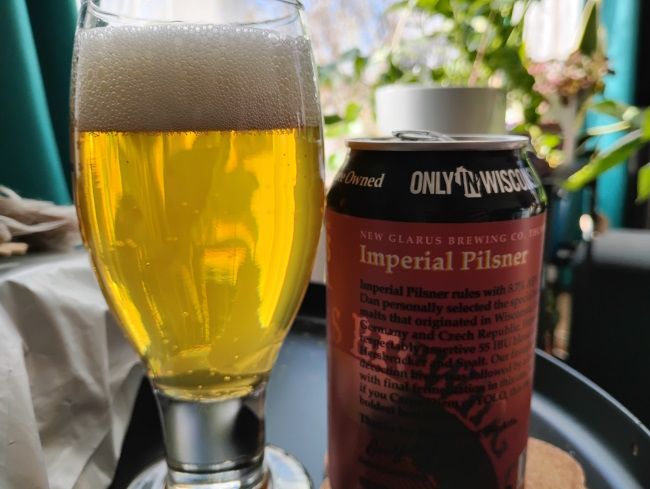Upon hearing that New Glarus was to release an imperial pilsner, my mind immediately said, "I've had one of those before!" and I recalled thinking that the ostensible pils was really just a helles bock given an "imperial" moniker for marketing cachet. Wasn't it from 3 Floyds? Then I recalled that Point had brewed one for their Whole Hog series but I never reviewed it. Going back through my blog, I realized it was, in fact, an imperial helles from Southern Tier that seemed to me better described as a helles bock.
I also discovered that Lakefront brewed an imperial pilsner as the 9th entry in their My Turn series, Pilo. Furthermore, Chicago's 5 Rabbit Cervecería brewed one as well called Super Pils. (R.I.P. 5 Rabbit.)
New Glarus' brewmaster, Dan Carey, discussed the beer on the latest episode of New Glarus Brewing Podcast W/Dan Carey which I listened to with great interest and, by the time it came for me to sample one, I had forgotten everything he said about it except that it wasn't a big version of their regular strength pilsner, Pilsner. The label doesn't say what variety pilsener this is an imperial take on, though. It does say, however, that there are German and Czech malts in the recipe along with a trio of German hops: Diamant, Hersbrucker, and Spalt.
While I still feel that imperial pilsners are just helles bocks trying to get above their raisin', I chose this brew over New Glarus' other new beer, Tailwagger, as it is spring, the season for pale bocks.
This has to be one of the few beers from New Glarus that has the A.B.V. on the label - 8.7%. Dan Carey is not a boastful man, from my experience, so maybe this was to alert consumers who might stumble across one of these thinking, "Oh look, a pilsner! Pilsners are light colored, easy going, highly quaffable beers with a reasonable amount of alcohol."
Imperial Pilsner is of a slightly darker yellow than your typical German pils yet not quite the golden color of a helles bock. There was a smattering of bubbles inside that floated up to the big head of pure white foam. The aroma was very pilsnery with cracker, bread, and hay/grass to be had.
My first sip had a medium dose of fizz to it and revealed a medium-heavy body, the first real sign of the imperial here. That variety of grains in the recipe yielded a rich bready flavor (after decoction) [Mmm...decoction...] along with some honeyed malt sweetness. My tongue was pleased to also taste a bit more than enough grassy-herbal hops to balance out the big malty taste. The bready sweetness lingered on the finish for a bit until the hops, having taken on a spicier flavor, really dried things out and gave a firm dose of bitterness.
My sampling began with Imperial Pilsner right out of the refrigerator. At the nice cold temperature, sweetness was moderated and this stuff went down easily, not unlike a regular pils. As the liquid warmed, the honeyed sweetness became stronger and the beer became more bock-like. I scrambled to down the stuff before it became cloying and soon enough I had an empty glass before me as my head buzzed. I also found that I was a bit peckish.
I suppose that it was the extra hops that gave this brew a pilsner quality to distinguish it from a run of the mill helles doppelbock and I really appreciated the extra bitterness they gave to the cause to counter all that malt and the very dry finish. And that bready malt flavor was simply savory and delicious.
Imperial Pilsner is a fine spring beer but go easy on it and/or share your can with a friend or loved one.
Junk food pairing: Pair your Imperial Pilsner with a bag of Herr's Carolina Reaper Cheese Curls. Actually, with this beer's potency, get multiple bags. They have a rich cheesy taste and the chili dust adds a firm, though not deadly, heat to complement the hearty hops.


No comments:
Post a Comment